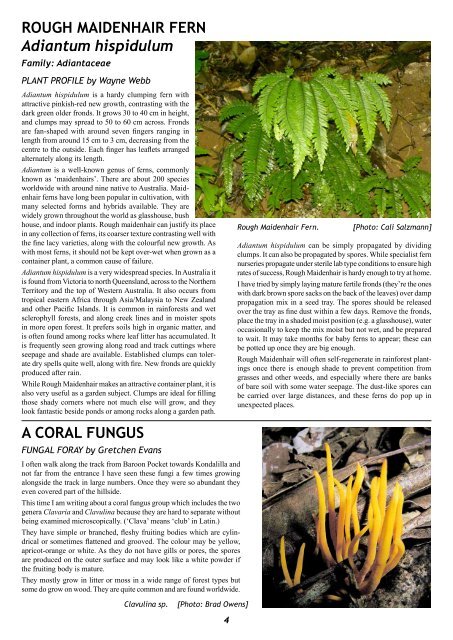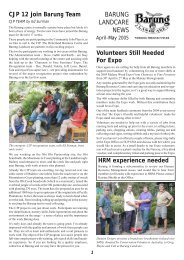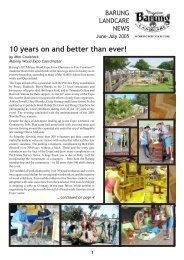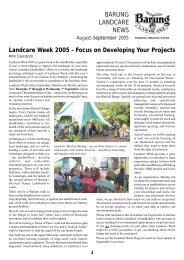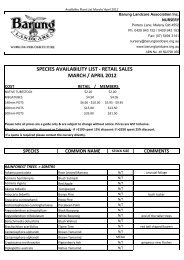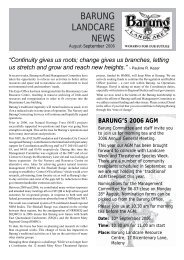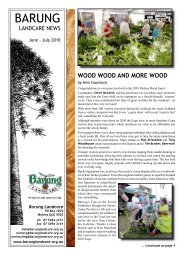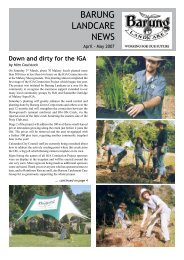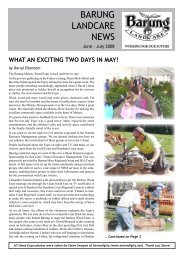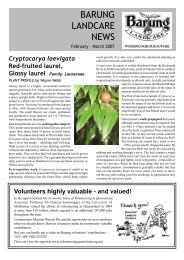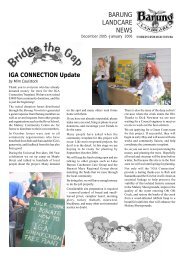June/July 2012 - Barung Landcare
June/July 2012 - Barung Landcare
June/July 2012 - Barung Landcare
You also want an ePaper? Increase the reach of your titles
YUMPU automatically turns print PDFs into web optimized ePapers that Google loves.
ROUGH MAIDENHAIR FERN<br />
Adiantum hispidulum<br />
Family: Adiantaceae<br />
PLANT PROFILE by Wayne Webb<br />
Adiantum hispidulum is a hardy clumping fern with<br />
attractive pinkish-red new growth, contrasting with the<br />
dark green older fronds. It grows 30 to 40 cm in height,<br />
and clumps may spread to 50 to 60 cm across. Fronds<br />
are fan-shaped with around seven fingers ranging in<br />
length from around 15 cm to 3 cm, decreasing from the<br />
centre to the outside. Each finger has leaflets arranged<br />
alternately along its length.<br />
Adiantum is a well-known genus of ferns, commonly<br />
known as ‘maidenhairs’. There are about 200 species<br />
worldwide with around nine native to Australia. Maidenhair<br />
ferns have long been popular in cultivation, with<br />
many selected forms and hybrids available. They are<br />
widely grown throughout the world as glasshouse, bush<br />
house, and indoor plants. Rough maidenhair can justify its place<br />
in any collection of ferns, its coarser texture contrasting well with<br />
the fine lacy varieties, along with the colourful new growth. As<br />
with most ferns, it should not be kept over-wet when grown as a<br />
container plant, a common cause of failure.<br />
Adiantum hispidulum is a very widespread species. In Australia it<br />
is found from Victoria to north Queensland, across to the Northern<br />
Territory and the top of Western Australia. It also occurs from<br />
tropical eastern Africa through Asia/Malaysia to New Zealand<br />
and other Pacific Islands. It is common in rainforests and wet<br />
sclerophyll forests, and along creek lines and in moister spots<br />
in more open forest. It prefers soils high in organic matter, and<br />
is often found among rocks where leaf litter has accumulated. It<br />
is frequently seen growing along road and track cuttings where<br />
seepage and shade are available. Established clumps can tolerate<br />
dry spells quite well, along with fire. New fronds are quickly<br />
produced after rain.<br />
While Rough Maidenhair makes an attractive container plant, it is<br />
also very useful as a garden subject. Clumps are ideal for filling<br />
those shady corners where not much else will grow, and they<br />
look fantastic beside ponds or among rocks along a garden path.<br />
Rough Maidenhair Fern.<br />
[Photo: Cali Salzmann]<br />
Adiantum hispidulum can be simply propagated by dividing<br />
clumps. It can also be propagated by spores. While specialist fern<br />
nurseries propagate under sterile lab type conditions to ensure high<br />
rates of success, Rough Maidenhair is hardy enough to try at home.<br />
I have tried by simply laying mature fertile fronds (they’re the ones<br />
with dark brown spore sacks on the back of the leaves) over damp<br />
propagation mix in a seed tray. The spores should be released<br />
over the tray as fine dust within a few days. Remove the fronds,<br />
place the tray in a shaded moist position (e.g. a glasshouse), water<br />
occasionally to keep the mix moist but not wet, and be prepared<br />
to wait. It may take months for baby ferns to appear; these can<br />
be potted up once they are big enough.<br />
Rough Maidenhair will often self-regenerate in rainforest plantings<br />
once there is enough shade to prevent competition from<br />
grasses and other weeds, and especially where there are banks<br />
of bare soil with some water seepage. The dust-like spores can<br />
be carried over large distances, and these ferns do pop up in<br />
unexpected places.<br />
A CORAL FUNGUS<br />
FUNGAL FORAY by Gretchen Evans<br />
I often walk along the track from Baroon Pocket towards Kondalilla and<br />
not far from the entrance I have seen these fungi a few times growing<br />
alongside the track in large numbers. Once they were so abundant they<br />
even covered part of the hillside.<br />
This time I am writing about a coral fungus group which includes the two<br />
genera Clavaria and Clavulina because they are hard to separate without<br />
being examined microscopically. (‘Clava’ means ‘club’ in Latin.)<br />
They have simple or branched, fleshy fruiting bodies which are cylindrical<br />
or sometimes flattened and grooved. The colour may be yellow,<br />
apricot-orange or white. As they do not have gills or pores, the spores<br />
are produced on the outer surface and may look like a white powder if<br />
the fruiting body is mature.<br />
They mostly grow in litter or moss in a wide range of forest types but<br />
some do grow on wood. They are quite common and are found worldwide.<br />
Clavulina sp.<br />
[Photo: Brad Owens]<br />
4


